People
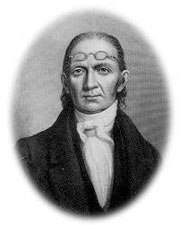 John Shepard (1765 - 1837) - one of the early pioneers of the Valley area. He was born in Connecticut, and came to the Valley in 1784 at the age of 19. He worked as a clerk in Tioga Point. Four years later, at the age of 23, he purchased 600 acres of land hincluding a grist mill and saw mill in Milltown on Tioga Creek (now known as Shepard Creek). which became known as Milltown. Milltown was rightfully named with having the only grist and sawmills on the Susquehanna River between Binghamton, New York, and Wyoming, Pennsylvania. Shepard went on to build more industries in Milltown, eventually acquiring thousands and thousands of acres of property. By the end of the 1700s he also owned a fulling mill, and oil mill and a distillery. John Shepard became one of the most successful business men of his time.
Shepard would later donate property located on what is now Bradford Street in Sayre. The property would be the site of the first log cabin school house in the area. The current location is now home to the Rest Cemetery. Interesting enough, many of the Shepard clan are interred at the Rest Cemetery.
John Shepard (1765 - 1837) - one of the early pioneers of the Valley area. He was born in Connecticut, and came to the Valley in 1784 at the age of 19. He worked as a clerk in Tioga Point. Four years later, at the age of 23, he purchased 600 acres of land hincluding a grist mill and saw mill in Milltown on Tioga Creek (now known as Shepard Creek). which became known as Milltown. Milltown was rightfully named with having the only grist and sawmills on the Susquehanna River between Binghamton, New York, and Wyoming, Pennsylvania. Shepard went on to build more industries in Milltown, eventually acquiring thousands and thousands of acres of property. By the end of the 1700s he also owned a fulling mill, and oil mill and a distillery. John Shepard became one of the most successful business men of his time.
Shepard would later donate property located on what is now Bradford Street in Sayre. The property would be the site of the first log cabin school house in the area. The current location is now home to the Rest Cemetery. Interesting enough, many of the Shepard clan are interred at the Rest Cemetery.
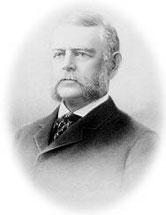 Howard Elmer (1833 - 1892) A Waverly banker who had a vision for the Pine Plains located between Waverly and Athens. In 1870, Mr. Elmer, and other investors purchased the Plains and proceeded to convince Asa Packer to locate a new railroad repair facility on this land. A rail executive who helped Mr. Elmer cement the deal was rewarded by having the town named for him - he was Robert H. Sayre.
Howard Elmer (1833 - 1892) A Waverly banker who had a vision for the Pine Plains located between Waverly and Athens. In 1870, Mr. Elmer, and other investors purchased the Plains and proceeded to convince Asa Packer to locate a new railroad repair facility on this land. A rail executive who helped Mr. Elmer cement the deal was rewarded by having the town named for him - he was Robert H. Sayre.
 James Fritcher (1811-1871) Born in Canajoharie, New York. Fritcher resided in Waverly. He was one of Howard Elmer’s investors for the Pine Plains. Fricher passed away in Waverly, and interred in Athens, at the Tioga Point Cemetery. (Memorial ID 89766822)
James Fritcher (1811-1871) Born in Canajoharie, New York. Fritcher resided in Waverly. He was one of Howard Elmer’s investors for the Pine Plains. Fricher passed away in Waverly, and interred in Athens, at the Tioga Point Cemetery. (Memorial ID 89766822)
 Charles Anthony Jr. (1816-?) Lived in Gouverneur, New York. Information on Anthony was associated with Howard Elmer and James Fritcher is not well documented. We know Anthony was the President of The Gouverneur Bank in Gouverneur, New York. Anthony was an investor in the Waverly Bank. Howard Elmer used those funds to help financed the development of Sayre, Pennsylvania.
Charles Anthony Jr. (1816-?) Lived in Gouverneur, New York. Information on Anthony was associated with Howard Elmer and James Fritcher is not well documented. We know Anthony was the President of The Gouverneur Bank in Gouverneur, New York. Anthony was an investor in the Waverly Bank. Howard Elmer used those funds to help financed the development of Sayre, Pennsylvania.
 Asa Packer (1805 - 1879) Asa Packer was the Founder of the Lehigh Valley Railroad along with Lehigh University. Asa Packer was member of the Pennsylvania House Representatives in addition to being an Associate Judge for Carbon County. Packer lived what is now Jim Thorpe, Pennsylvania, and was considered the wealthiest individual in all of Pennsylvania. Howard Elmer convinced Mr. Packer to locate the Lehigh Valley Railroad workshops to Pine Plains now Sayre, PA.
Asa Packer (1805 - 1879) Asa Packer was the Founder of the Lehigh Valley Railroad along with Lehigh University. Asa Packer was member of the Pennsylvania House Representatives in addition to being an Associate Judge for Carbon County. Packer lived what is now Jim Thorpe, Pennsylvania, and was considered the wealthiest individual in all of Pennsylvania. Howard Elmer convinced Mr. Packer to locate the Lehigh Valley Railroad workshops to Pine Plains now Sayre, PA.
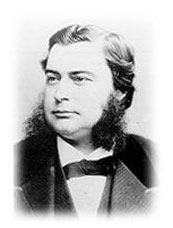 Robert Asa Packer (1842 - 1883) Robert Asa Packer was the son of Asa Packer. He was an investor in Howard Elmer's Sayre Land Company and with Elmer was one of the key players in the promotion of the development of Sayre. Robert Packer built a large Victorian mansion in Sayre, PA. After his death, his sister, Mary Packer Cummings, donated his mansion to be used as a hospital. Today, the Robert Packer Hospi- tal stands on the property, once was the Packer Mansion.
Robert Asa Packer (1842 - 1883) Robert Asa Packer was the son of Asa Packer. He was an investor in Howard Elmer's Sayre Land Company and with Elmer was one of the key players in the promotion of the development of Sayre. Robert Packer built a large Victorian mansion in Sayre, PA. After his death, his sister, Mary Packer Cummings, donated his mansion to be used as a hospital. Today, the Robert Packer Hospi- tal stands on the property, once was the Packer Mansion.
 Mary Packer Cummings (1839–1912 )
Without the generosity of Mary Packer Cummings the Robert Packer Hospital would not exist. Upon the death of her brother, Robert Packer, she donated his mansion in Sayre to be used as a hospital. The hospital would be enlarged many times over. The mansion was demolished in 1961. However, the Robert Packer Hospital continues to expand and is an intricate part of Sayre and its history. Upon her passing, Cummings was the wealthiest woman in the world only second to Queen Victoria.
Mary Packer Cummings (1839–1912 )
Without the generosity of Mary Packer Cummings the Robert Packer Hospital would not exist. Upon the death of her brother, Robert Packer, she donated his mansion in Sayre to be used as a hospital. The hospital would be enlarged many times over. The mansion was demolished in 1961. However, the Robert Packer Hospital continues to expand and is an intricate part of Sayre and its history. Upon her passing, Cummings was the wealthiest woman in the world only second to Queen Victoria.
 Harry Packer (1850-1884) was the youngest son of Asa and Sarah Packer. He was a life long resident of Mauch Chunk, (now Jim Thorpe), Pennsylvania. Harry would go on to marry the daughter of Robert Lockhart.
Once Harry graduated from Lehigh University, he joined the family business. Harry become a director at the Lehigh Valley Railroad. He would be elevated to vice president to eventually being the president of the Leigh Valley Railroad. Not only was Harry Packer invested in the Lehigh Valley Railroad, the coal industry was another investment. Harry was president of the Schrader Coal Company. By investing in coal, it secured the fuel for the Lehigh Valley Railroad. Harry, his brother Robert, cousin E.P. Wilbur and Harry along Robert Lockhart would buy out Anthony’s share of the Sayre Land Company.
Harry Packer (1850-1884) was the youngest son of Asa and Sarah Packer. He was a life long resident of Mauch Chunk, (now Jim Thorpe), Pennsylvania. Harry would go on to marry the daughter of Robert Lockhart.
Once Harry graduated from Lehigh University, he joined the family business. Harry become a director at the Lehigh Valley Railroad. He would be elevated to vice president to eventually being the president of the Leigh Valley Railroad. Not only was Harry Packer invested in the Lehigh Valley Railroad, the coal industry was another investment. Harry was president of the Schrader Coal Company. By investing in coal, it secured the fuel for the Lehigh Valley Railroad. Harry, his brother Robert, cousin E.P. Wilbur and Harry along Robert Lockhart would buy out Anthony’s share of the Sayre Land Company.
 E.P. (Elisha Packer) Wilbur (1833-1914) was born in Mystic, Connecticut and lived in Bethlehem, Pennsylvania. Wilbur was a nephew of the founder of the Lehigh Valley Railroad, Asa Packer. Mr. Wilbur would eventually become the president of the Lehigh Valley Railroad. E.P. Wilbur was an industrious individual. He would also hold the title of as president of the E.P. Wilbur Trust, one of the first banks in the Leigh Valley, Pennyslvania area. Wilbur was also a trustee for the Leigh University, St. Lukes Hospital, and a partner of the Sayre Land Company in Sayre. A son Harry Packer Wilbur would become the president of the Sayre Land and Water Company in Sayre. Today, you can drive or walk down a street in Sayre named, Wilbur Avenue.
E.P. (Elisha Packer) Wilbur (1833-1914) was born in Mystic, Connecticut and lived in Bethlehem, Pennsylvania. Wilbur was a nephew of the founder of the Lehigh Valley Railroad, Asa Packer. Mr. Wilbur would eventually become the president of the Lehigh Valley Railroad. E.P. Wilbur was an industrious individual. He would also hold the title of as president of the E.P. Wilbur Trust, one of the first banks in the Leigh Valley, Pennyslvania area. Wilbur was also a trustee for the Leigh University, St. Lukes Hospital, and a partner of the Sayre Land Company in Sayre. A son Harry Packer Wilbur would become the president of the Sayre Land and Water Company in Sayre. Today, you can drive or walk down a street in Sayre named, Wilbur Avenue.
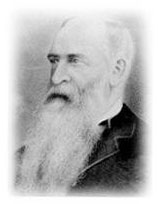 Robert Sayre 1824 - 1907) was an engineer who started his career in the canal business then moved into railroading. Robert Sayre would become the chief engineer for the development of the Lehigh Valley Railroad system. As the Lehigh Valley Rail Road pushed north to join the Erie Railroad in Waverly, New York. Howard Elmer convinced Robert Sayre to build a major railroad repair facility on some available farm land on the New York, Pennsylvania border. Sayre visited the area when before Sayre was built. He saw Pine Plains to become part of the Lehigh Valley Railroad. It is said, Sayre expressed to Elmer the area would make a good location for a city. Sayre committed to building the L.V.R.R. workshops and Elmer named the town in Sayre’s honor.
Robert Sayre 1824 - 1907) was an engineer who started his career in the canal business then moved into railroading. Robert Sayre would become the chief engineer for the development of the Lehigh Valley Railroad system. As the Lehigh Valley Rail Road pushed north to join the Erie Railroad in Waverly, New York. Howard Elmer convinced Robert Sayre to build a major railroad repair facility on some available farm land on the New York, Pennsylvania border. Sayre visited the area when before Sayre was built. He saw Pine Plains to become part of the Lehigh Valley Railroad. It is said, Sayre expressed to Elmer the area would make a good location for a city. Sayre committed to building the L.V.R.R. workshops and Elmer named the town in Sayre’s honor.
 Robert Lockhart (1829-1900) was from Bethlehem, Pennsylvania . Robert Lockhart became a successful investor in the coal industry. He was also a close friend of the founder of the Lehigh Valley Railroad, Asa Packer. Lockhart would contract with Packer to provide the coal fuel needed by the Lehigh Valley Railroad. Lockhart would also become an investor in the Sayre Land Company and eventually replace Howard Elmer as the president of the Sayre Land Company. The Sayre Land Company was located on the corner of West Lockhart Street and North Lehigh Avenue. The Lockhart Building was constructed in 1897, named after Lockhart.
Robert Lockhart (1829-1900) was from Bethlehem, Pennsylvania . Robert Lockhart became a successful investor in the coal industry. He was also a close friend of the founder of the Lehigh Valley Railroad, Asa Packer. Lockhart would contract with Packer to provide the coal fuel needed by the Lehigh Valley Railroad. Lockhart would also become an investor in the Sayre Land Company and eventually replace Howard Elmer as the president of the Sayre Land Company. The Sayre Land Company was located on the corner of West Lockhart Street and North Lehigh Avenue. The Lockhart Building was constructed in 1897, named after Lockhart.
 Dr. Donald Guthrie was born in Wilkes-Barre, PA in 1880 the son of a prominent Pennsylvania family and physician. His formal education was completed at Yale University, the Medical School at the University of Pennsylvania where he received his Doctor of Medicine degree. He served a one-year internship at Wilks-Barrie General Hospital followed by a three and a half year position as surgical resident at the Mayo Clinic in Rochester, Minnesota. Dr. Guthrie, at the age of 30, was hired as surgeon-in-chief of the 25-year-old Robert Packer Hospital January 1910. For his services he received $1500 per year, use of a residence with heat and receipt of operating fees from paying patients after payment in full of all hospital charges were satisfied. The 25-bed hospital was in need of repair, $35,000 in debt, with no operating funds, or equipment save one wheel chair when Dr Guthrie took charge. In his tenure a 345-bed hospital was built and 78 full time doctors staffed the Guthrie Clinic. His philosophy was simple - provide the best in service, ability and tools; keep the lowliest detail at the highest level; observe everything both at home and abroad to bring the newest in medicine to Sayre. An interesting tribute to Dr. Guthrie - when Dr Mayo's, son Charles, finished medical school he came to the Robert Packer Hospital to serve his internship under Dr. Guthrie. Dr. Guthrie remained active in his leadership roll until failing health forced him to step aside in 1957 - he died the following year on October 30.
Dr. Donald Guthrie was born in Wilkes-Barre, PA in 1880 the son of a prominent Pennsylvania family and physician. His formal education was completed at Yale University, the Medical School at the University of Pennsylvania where he received his Doctor of Medicine degree. He served a one-year internship at Wilks-Barrie General Hospital followed by a three and a half year position as surgical resident at the Mayo Clinic in Rochester, Minnesota. Dr. Guthrie, at the age of 30, was hired as surgeon-in-chief of the 25-year-old Robert Packer Hospital January 1910. For his services he received $1500 per year, use of a residence with heat and receipt of operating fees from paying patients after payment in full of all hospital charges were satisfied. The 25-bed hospital was in need of repair, $35,000 in debt, with no operating funds, or equipment save one wheel chair when Dr Guthrie took charge. In his tenure a 345-bed hospital was built and 78 full time doctors staffed the Guthrie Clinic. His philosophy was simple - provide the best in service, ability and tools; keep the lowliest detail at the highest level; observe everything both at home and abroad to bring the newest in medicine to Sayre. An interesting tribute to Dr. Guthrie - when Dr Mayo's, son Charles, finished medical school he came to the Robert Packer Hospital to serve his internship under Dr. Guthrie. Dr. Guthrie remained active in his leadership roll until failing health forced him to step aside in 1957 - he died the following year on October 30.
Dr. and Mrs. Guthrie’s home was located on Packer Avenue.
Memoir of Donald Guthrie by Hugh Robertson, M.D.
Mrs. J. W. Bishop, nee Mary Wells
Born in 1850 in Meshoppen, PA, the daughter of Dr. Nathan and Mary Horton Wells, Mary was one of four children. She married Joseph W. Bishop in 1872; they resided in Towanda until 1876 when they moved to Sayre as part of the Lehigh Valley Railroad general offices placement there. Her husband was employed by the Lehigh Valley Railroad from 1867 until 1894, at which time he entered into a retail coal business, the Bishop Coal Company.  The Bishops built a home at 101 Park Place in 1879. They had four children, Howard Elmer, who was an administrator at the Robert Packer Hospital from 1913 to 1951, Louise, Nathan Wells, and Katherine Wells, who married Rev. Frank Thurber Cady. Their son, Dr. Joseph Cady, served on the staff of the Robert Packer Hospital and Guthrie Clinic. Present when the history of Sayre was developing, Mrs. Bishop knew those personages about whom she wrote and who are historic figures today.
The Bishops built a home at 101 Park Place in 1879. They had four children, Howard Elmer, who was an administrator at the Robert Packer Hospital from 1913 to 1951, Louise, Nathan Wells, and Katherine Wells, who married Rev. Frank Thurber Cady. Their son, Dr. Joseph Cady, served on the staff of the Robert Packer Hospital and Guthrie Clinic. Present when the history of Sayre was developing, Mrs. Bishop knew those personages about whom she wrote and who are historic figures today.
Mrs. Bishop was a charter member of the Tioga Point Chapter of the Daughters of the American Revolution. She played a part in the founding of the Sayre Library and the Monday Club. She was one of the first communicants of the Church of the Redeemer where she played the organ.
She died on October 29, 1929. She and her husband are buried in the Tioga Point Cemetery in Athens, PA.
Her "Short History of Sayre" gives a glimpse into the earliest time of the development of Sayre.
Data compiled from information from James R. Nobles and from an article by Henry Farley in Volume 8, Number 1 of the Spring 1999 issue.
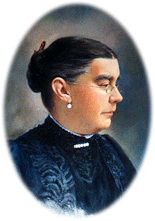 Mary Hannah Packer Cummings
Mary Hannah Packer Cummings
In honor of National Women's History Month in March, we present Mary Hannah Packer Cummings, the woman who was instrumental in the formation of the Robert Packer Hospital.
It was she who after the 1883 death of her brother Robert gave the use and purpose of the vacant Robert Packer mansion as a hospital for the Lehigh Valley Railroad workers and their families. In 1885 the charter was granted and the Robert Packer Hospital was opened in July.
This singular act set in motion the establishment of what was to become the renowned Robert Packer Hospital.
Born in 1839 into the Asa Packer family of Mauch Chunck, now Jim Thorpe, Pennsylvania, Mary Packer was the third oldest of the seven Packer children. By the year 1885, she was the only remaining member of an illustrious family.
Her life mirrors that of a woman of her time no matter the extent of the family wealth. Even as the sole survivor but an unmarried woman, she was unable to gain control of the family wealth. However, in accord with the passing of the 1848 Married Women's Property Act, Mary Packer arranged a marriage with Charles Cummings complete with the first pre-nuptial agreement in Carbon County.
Upon her marriage in 1885, she inherited the family fortune of $54 million dollars, making her the wealthiest American woman, second only in the world to England's Queen Victoria.
She and Charles eventually divorced in 1893, but she retained her married last name
Mrs. Cummings became ill in August of 1912 and died in October. She was laid to rest in the family plot at Mauch Chunck Cemetery.
